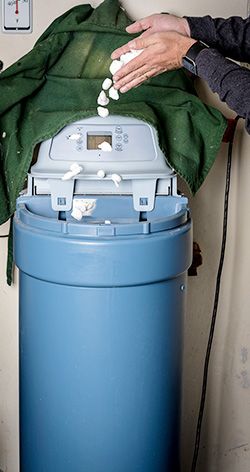 Depending on how hard your water is at home, a water softener system can be an important household appliance, and a little seasonal maintenance can keep it running smoothly.
Depending on how hard your water is at home, a water softener system can be an important household appliance, and a little seasonal maintenance can keep it running smoothly.
In some regions of the state, water can contain high levels of iron, calcium, and magnesium. When any of these are plentiful in your water, lime can build up and interfere with soap’s ability to clean. The presence of high levels of these minerals also can cause water to smell or taste bad.
RELATED: Should I get a water softener for my house?
What Do Water Softeners Do?
These small, and mostly inexpensive, appliances remove unwanted minerals from your home’s water supply. Water softeners soften hard water by exchanging iron, calcium, and magnesium for sodium. The hard water flows through what is called a resin tank. The resin tank contains resin beads, in which the minerals in hard water are exchanged for sodium. Minerals stick to the beads as they pass through the tank and allow softer water to come through.
Water softeners can last for many years with just a little maintenance. Regular checks and cleaning can extend the lifespan of the appliance.
RELATED: How to maintain your septic tank
Here Are a Few Tips on How to Maintain Your Water Softener:
- Salt is an important part of the softening system. Check the salt levels at least once per month. Consult your manual for the proper salt level in which your softener works best.
- Know what type of salt your system performs well on. The manual will tell you what type – granular, tablet or block salt – is best for your appliance. Pure rock salt with iron remover is generally recommended.
- Only add salt when most of the salt in the tank is used up.
- Break up any salt bridges or piles that may build up in your tank.
- Clean out your water softener if your water has turned hard.
- Empty the softener’s salt (brine) tank, disposing of any salt blocks or bridges. Rinse with hot water to dissolve any residue from the salt.
- Pour water softener cleaner into the brine tank once every few months. Use Iron-Out at least once a year to clean your system.
- Adjust valves and clean the valve between the brine and resin tanks.
- Check to make sure the drain line doesn’t get stuck down in a floor drain.
- Schedule the water softener to recharge at a time when water isn’t being used in your household — typically at night when everyone is sleeping.
While water softeners can cost anywhere from $500 to $1,000 to replace, most repairs rarely exceed $200. Before replacing your entire system, consult a professional.
